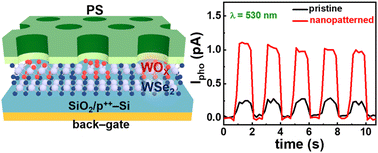Nanostructured doping of WSe2via block copolymer patterns and its self-powered photodetector application
Abstract
Transition metal dichalcogenides (TMDs), e.g., MoS2, MoSe2, ReS2, and WSe2, are effective materials for advanced optoelectronics owing to their intriguing optical, structural, and electrical properties. Various approaches for manipulating the surface of the TMDs have been suggested to unleash the optoelectronic potential of the TMDs. Herein, we employed the self-assembly of the poly(styrene-b-methyl methacrylate) (PS-b-PMMA) block copolymer (BCP) to prepare a nanoporous pattern and generate nanostructured charge-transfer p-doping on the WSe2 surface, maximizing the depletion region in the absorber layer. After the spin coating and thermal annealing of PS-b-PMMA, followed by the selective etching of PMMA cylindrical microdomains using oxygen reactive-ion plasma, nanopatterned WOx with high electron affinity was grown on the WSe2 surface, forming a three-dimensional homojunction. The nanopatterned WOx significantly expanded the depletion region in the WSe2 layer, thus enhancing optoelectronic performance and self-powered photodetection. The proposed approach based on the nanostructured doping of the TMDs via BCP nanolithography can help create a promising platform for highly functional optoelectrical devices.

- This article is part of the themed collection: Honorary themed collection for Thomas P. Russell


 Please wait while we load your content...
Please wait while we load your content...